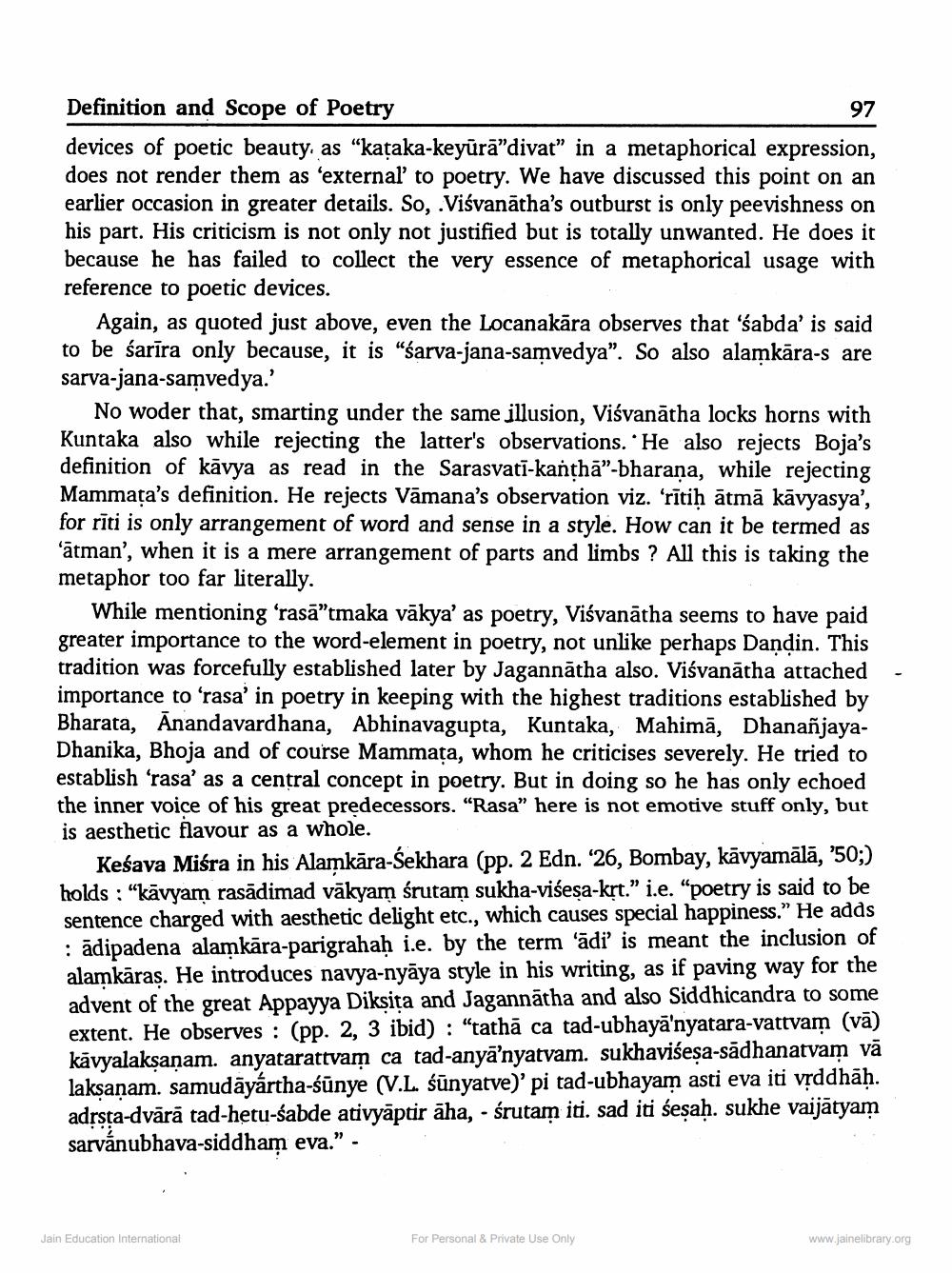________________
Definition and Scope of Poetry
97
devices of poetic beauty, as "kataka-keyūra"divat" in a metaphorical expression, does not render them as external' to poetry. We have discussed this point on an earlier occasion in greater details. So, Viśvanātha's outburst is only peevishness on his part. His criticism is not only not justified but is totally unwanted. He does it because he has failed to collect the very essence of metaphorical usage with reference to poetic devices.
Again, as quoted just above, even the Locanakāra observes that 'sabda' is said to be śarīra only because, it is “sarva-jana-samvedya”. So also alamkāra-s are sarva-jana-samvedya.'
No woder that, smarting under the same illusion, Viśvanātha locks horns with Kuntaka also while rejecting the latter's observations. He also rejects Boja's definition of kāvya as read in the Sarasvati-kanthā”-bharana, while rejecting Mammața's definition. He rejects Vāmana's observation viz. 'rītiḥ ātmā kāvyasya', for rīti is only arrangement of word and sense in a style. How can it 'ātman', when it is a mere arrangement of parts and limbs ? All this is taking the metaphor too far literally.
While mentioning 'rasā"tmaka vākya' as poetry, Viśvanātha seems to have paid greater importance to the word-element in poetry, not unlike perhaps Dandin. This tradition was forcefully established later by Jagannātha also. Viśvanātha attached importance to 'rasa' in poetry in keeping with the highest traditions established by Bharata, Anandavardhana, Abhinavagupta, Kuntaka, Mahimā, DhananjayaDhanika, Bhoja and of course Mammata, whom he criticises severely. He tried to establish 'rasa' as a central concept in poetry. But in doing so he has only echoed the inner voice of his great predecessors. “Rasa” here is not emotive stuff only, but is aesthetic flavour as a whole.
Keśava Miśra in his Alamkāra-Sekhara (pp. 2 Edn. 26, Bombay, kāvyamālā, '50;) holds : "kävyam rasādimad vākyam śrutam sukha-visesa-krt." i.e. “poetry is said to be sentence charged with aesthetic delight etc., which causes special happiness.” He adds : ādipadena alamkāra-parigrahaḥ i.e. by the term 'ādi' is meant the inclusion of alamkāras. He introduces navya-nyāya style in his writing, as if paving way for the advent of the great Appayya Diksiţa and Jagannātha and also Siddhicandra to some extent. He observes : (pp. 2, 3 ibid) : “tathā ca tad-ubhayā'nyatara-vattvam (vā) kavyalaksanam. anyatarattvam ca tad-anya'nyatvam. sukhaviśesa-sādhanatvam vā laksanam. samudāyártha-sūnye (V.L. śūnyatve)'pi tad-ubhayam asti eva iti vrddhāḥ. adrsta-dvārā tad-hętu-sabde ativyāptir āha, - śrutam iti. sad iti śeṣaḥ. sukhe vaijātyam sarvánubhava-siddham eva.” -
-
Jain Education International
For Personal & Private Use Only
www.jainelibrary.org




